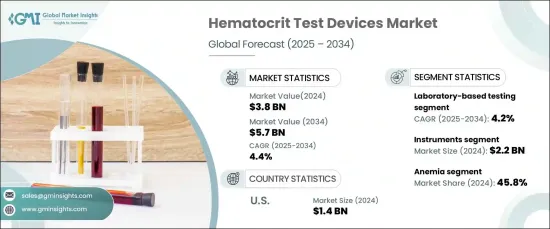PUBLISHER: Global Market Insights Inc. | PRODUCT CODE: 1665279

PUBLISHER: Global Market Insights Inc. | PRODUCT CODE: 1665279
Hematocrit Test Devices Market Opportunity, Growth Drivers, Industry Trend Analysis, and Forecast 2025 - 2034
The Global Hematocrit Test Devices Market was valued at USD 3.8 billion in 2024 and is projected to expand at a CAGR of 4.4% from 2025 to 2034. This robust growth is driven by a rising prevalence of blood disorders, a growing aging population, and continuous advancements in point-of-care testing technologies. The increasing demand for precise and efficient diagnostic tools positions hematocrit test devices as a critical component in healthcare delivery.

The market is segmented into instruments, reagents, and consumables, with the instruments category-comprising hematocrit test analyzers and meters-leading the charge. In 2024, this segment generated the highest revenue of USD 2.2 billion. These devices are indispensable for the regular monitoring of blood cell concentrations, underscoring their necessity in both medical and diagnostic settings.
| Market Scope | |
|---|---|
| Start Year | 2024 |
| Forecast Year | 2025-2034 |
| Start Value | $3.8 Billion |
| Forecast Value | $5.7 Billion |
| CAGR | 4.4% |
Additionally, the market is categorized by testing type, including laboratory-based testing and point-of-care (POC) testing. Laboratory-based testing emerged as the dominant segment, accounting for USD 2.5 billion in revenue in 2024. With a projected CAGR of 4.2% from 2025 to 2034, this segment continues to thrive due to its ability to deliver highly precise and reliable results. Laboratory-based hematocrit testing devices are crucial for diagnosing a range of conditions, such as anemia, polycythemia, and dehydration, making them an essential tool in healthcare diagnostics.
The U.S. remains a significant market player, with hematocrit test devices generating USD 1.4 billion in revenue in 2024. This segment is forecasted to grow at a CAGR of 3.9% between 2025 and 2034. The increasing prevalence of blood disorders, such as anemia, sickle cell disease, and polycythemia, within the U.S. population fuels the demand for reliable hematocrit testing equipment. The adoption of these devices spans clinical and home healthcare settings, ensuring their pivotal role in patient monitoring and care.
Table of Contents
Chapter 1 Methodology and Scope
- 1.1 Market scope and definitions
- 1.2 Research design
- 1.2.1 Research approach
- 1.2.2 Data collection methods
- 1.3 Base estimates and calculations
- 1.3.1 Base year calculation
- 1.3.2 Key trends for market estimation
- 1.4 Forecast model
- 1.5 Primary research and validation
- 1.5.1 Primary sources
- 1.5.2 Data mining sources
Chapter 2 Executive Summary
- 2.1 Industry 3600 synopsis
Chapter 3 Industry Insights
- 3.1 Industry ecosystem analysis
- 3.2 Industry impact forces
- 3.2.1 Growth drivers
- 3.2.1.1 Increasing prevalence of blood disorders
- 3.2.1.2 Growing demand for point-of-care testing
- 3.2.1.3 Technological advancements in hematology testing
- 3.2.2 Industry pitfalls and challenges
- 3.2.2.1 High cost of advanced hematocrit devices
- 3.2.1 Growth drivers
- 3.3 Growth potential analysis
- 3.4 Regulatory landscape
- 3.5 Technology landscape
- 3.6 Porter’s analysis
- 3.7 PESTEL analysis
- 3.8 Gap analysis
- 3.9 Future market trends
- 3.10 Value chain analysis
Chapter 4 Competitive Landscape, 2024
- 4.1 Introduction
- 4.2 Company matrix analysis
- 4.3 Company market share analysis
- 4.4 Competitive analysis of major market players
- 4.5 Competitive positioning matrix
- 4.6 Strategy dashboard
Chapter 5 Market Estimates and Forecast, By Product, 2021 – 2034 ($ Mn)
- 5.1 Key trends
- 5.2 Instruments
- 5.2.1 Hematocrit test analyzer
- 5.2.2 Hematocrit test meter
- 5.3 Reagents and consumables
Chapter 6 Market Estimates and Forecast, By Modality, 2021 – 2034 ($ Mn)
- 6.1 Key trends
- 6.2 Laboratory-based testing
- 6.3 Point-of-care (POC) testing
Chapter 7 Market Estimates and Forecast, By Application, 2021 – 2034 ($ Mn)
- 7.1 Key trends
- 7.2 Anemia
- 7.3 Congenital heart diseases
- 7.4 Polycythemia vera
- 7.5 Other applications
Chapter 8 Market Estimates and Forecast, By End Use, 2021 – 2034 ($ Mn)
- 8.1 Key trends
- 8.2 Hospitals
- 8.3 Diagnostic laboratories
- 8.4 Ambulatory surgical centers
- 8.5 Other end users
Chapter 9 Market Estimates and Forecast, By Region, 2021 – 2034 ($ Mn)
- 9.1 Key trends
- 9.2 North America
- 9.2.1 U.S.
- 9.2.2 Canada
- 9.3 Europe
- 9.3.1 Germany
- 9.3.2 UK
- 9.3.3 France
- 9.3.4 Spain
- 9.3.5 Italy
- 9.3.6 Netherlands
- 9.4 Asia Pacific
- 9.4.1 China
- 9.4.2 Japan
- 9.4.3 India
- 9.4.4 Australia
- 9.4.5 South Korea
- 9.5 Latin America
- 9.5.1 Brazil
- 9.5.2 Mexico
- 9.5.3 Argentina
- 9.6 Middle East and Africa
- 9.6.1 South Africa
- 9.6.2 Saudi Arabia
- 9.6.3 UAE
Chapter 10 Company Profiles
- 10.1 MENARINI Group
- 10.2 Abbott
- 10.3 BIO-RAD
- 10.4 Boule
- 10.5 Danaher
- 10.6 Diatron
- 10.7 EKF Diagnostics
- 10.8 Roche
- 10.9 HORIBA Medical
- 10.10 Mindray
- 10.11 NIHON KOHDEN
- 10.12 Nova Biomedical
- 10.13 SENSA CORE
- 10.14 SIEMENS Healthineers
- 10.15 Sysmex




